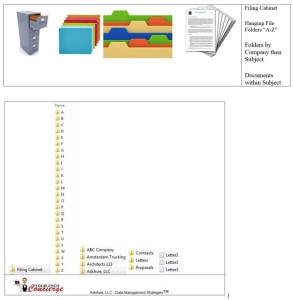“Where’s Your Data?”
📂📁 Easy way to Organize your Files📁📂
We all create it, yet how do we manage it?…
“Where’s your data?” You create it, you store it, hopefully, you’ve taken my advice and backed it up – yet I’ve found through my years of work with individuals, companies, and professionals – this question often remains. From e-mail storage, to pictures, to music, to important proposals, accounting files and databases, many USE their information on a daily basis, but ask them where it actually RESIDES on their digital devices or servers, and you’ll get a blank stare and a shoulder shrug. The most important component of their digital world is often a mystery. Without knowing WHERE it is, it is difficult to manage it. So what do YOU do?
Your Tech Concierge™ advises that to manage your data, you must first establish a structure to organize your personally created files so that you can easily store and retrieve them. Knowing WHERE you store and place your files is the first step in the data management cycle. The “WHERE” includes the physical storage location which might be your local hard drive, a USB storage device, a Network Attached Storage device, a Server, or a Cloud storage host. In addition to the physical device, the location where you save your data on that device is important for easy access. That leads us to Step 2 of the cycle.
Step 2 in the data management cycle is establishing the “HOW?” Individual needs tend to dictate the “HOW?”, yet initially, for most of us, mimicking a Paper-Style organization strategy helps us to easily visualize a workable system of cabinets, drawers, folders and files. Picturing a storage location as a “cabinet” and within that “cabinet” having “drawers” or what we call “directories”, and within those “directories” having defined “folders” and within those our individual files, we build an easily manageable structure to work within. As an example of this approach, you might have a location or “Cabinet” on your “WHERE (the storage device)” named “Filing Cabinet”. “Filing Cabinet” would be a primary storage location for all of your related “files”. Within that “Filing Cabinet”, you create 26 drawers or “folders” named “A” thru “Z”. Within each “drawer folder”, you would structure your hanging file folders by Company Name, Client Name, or Subject – alphabetically. And within each “Hanging File Folder” you would place “Manilla Folders” by subject, and lastly, saving the related subject files inside. Pictures are worth a thousand words:

Being diligent and systematic about where and how you store your data will help you quickly locate it when you need it, move it and transfer it as needed and also help you more effectively organize your backup strategies. This approach works on both Windows and Mac platforms as well as any storage medium. For the readers of this article, I’d very much appreciate the opportunity to answer your specific “Data Management” questions and help you with implementation concerns. Please send me your comments and I’ll be certain to post your remarks in a future article.
If you’d like to download the File Cabinet .zip file template that I use, Click Here and Save the the File Cabinet to your PC or Mac . Extract the .zip file in your documents directory or directory of choice and it’s ready to go!
This is 17th in a series of aSKaVIE articles devoted to your productivity, digital privacy and protection. In future articles, you can look forward to tips and tricks that you can use to make sense out of your digital investments as well as reviews of new and exciting things that will likely provide value to your home and business. I invite you to write me with your questions and feedback. We’ll also be helping and inspiring others by answering your questions and that’s what makes my job so much fun! So stay tuned. Please send your questions to questions@askavie.com.
About Avie Uniglicht: For over 30-years, Avie Uniglicht – “Your Tech Concierge™” has provided technology support and solutions to entrepreneurs who don’t have time to worry about the details. Specializing in “White-Glove Remote Room-Service,” Avie’s concept of giving you, his client, virtual “house calls” is cited regularly as invaluable and many of Avie’s clients say they couldn’t live without him on speed dial. Avie graduated Summa Cum Laude from Temple University with a BS in Business Administration. A former auditor for Price Waterhouse and past President of Ace Computer Center Inc., he is also the author of the e-Book, “Your Personal Computer Driver’s License.” Avie’s extensive business background and strong experience in accounting enhances his natural talent for helping his clients see the bigger picture regarding their business. “Your Tech Concierge” helps clients evaluate strategy so that together, they create an action plan with the end in mind. For more information or to “Ask Avie,” please call him at (888)-374-3712, and visit www.askavie.com.
